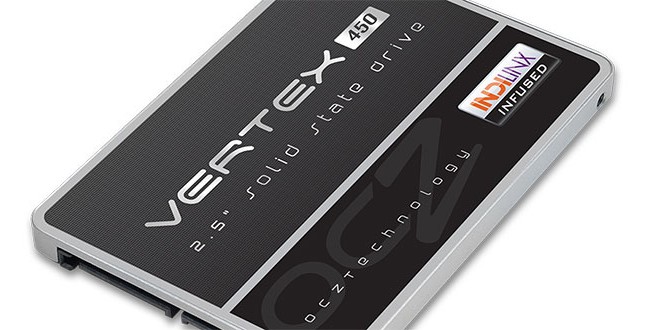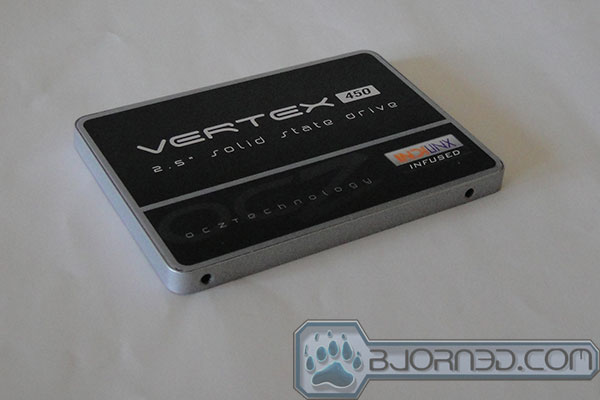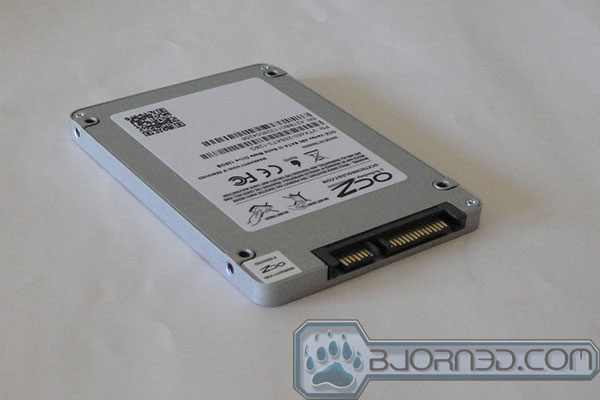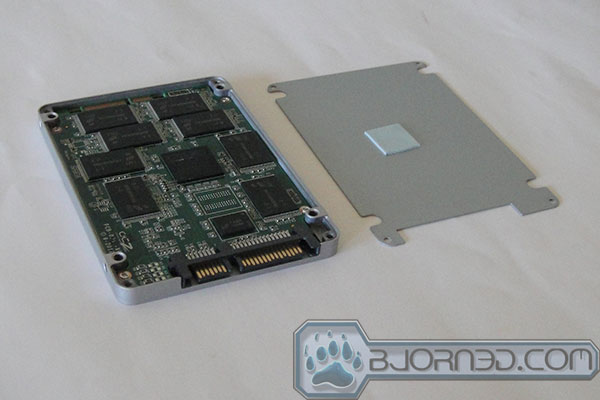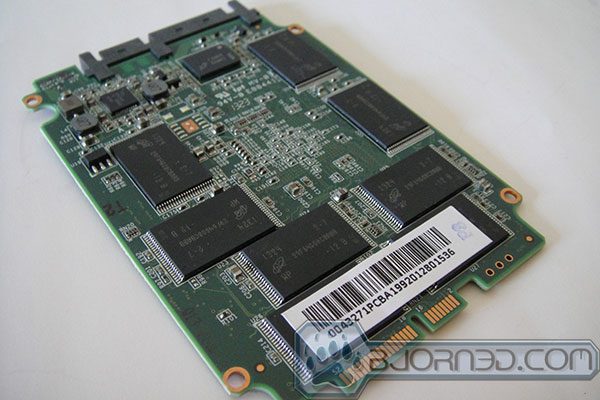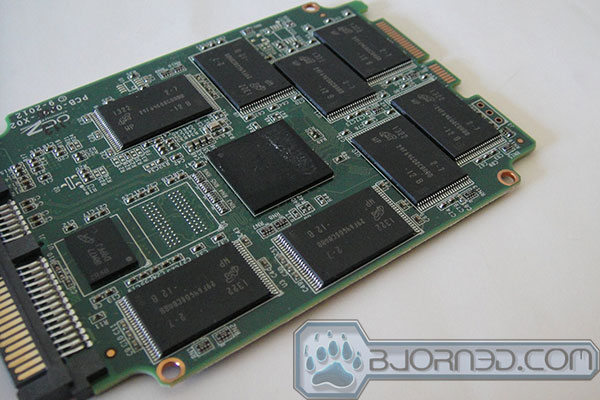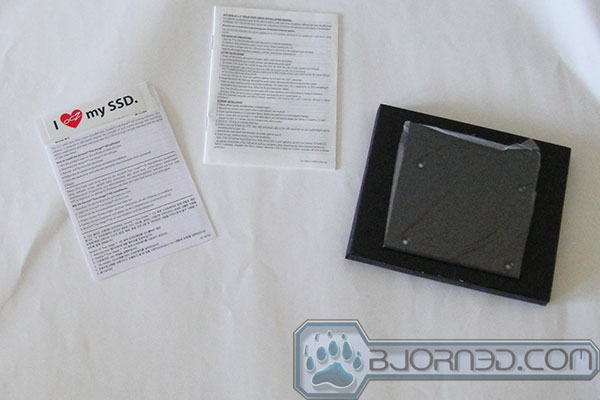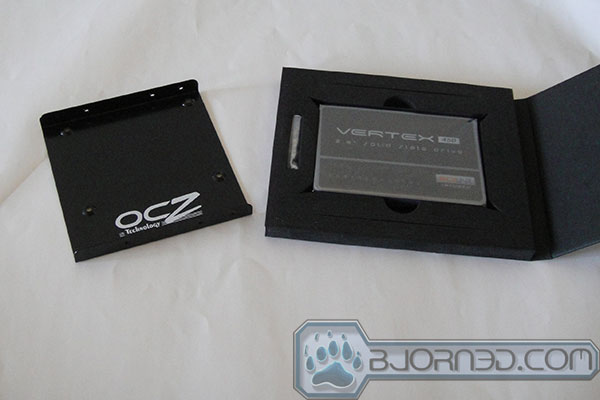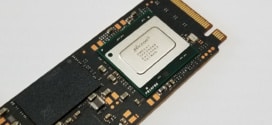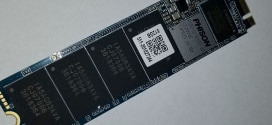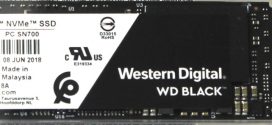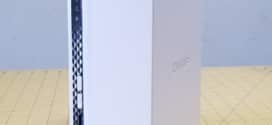Looking at the model number of the OCZ Vertex 450 and you would be thinking that the product falls in the same family as the Vertex 4. However, the only thing that the Vertex 450 shares with the Vertex 4 is only the branding of Vertex. Other than that, the Vertex 450 actually is more closely related to the performance Vector series SSD that OCZ has launched late last year.
The Vertex 450 uses the same Barefoot III (part number IDX500M10-BC) controller as the Vector but instead of using 25nm NAND MLC chip as the Vector, the Vertex 450 is paired with the die-shrunk 20nm MLC NAND. The shift to 20nm fabrication process is inevitable in order to save costs and to increase the NAND capacity so that manufacturers could pack more bits per die. This not only drives the price of the SSD down but also helps to increase the storage capacity. While the price of SSD is still relatively expensive compared to hard drivse (and it probably will never reach to the point of the HDD in any foreseeable future), the price has at least gotten to sub $1 per gigabyte, much more affordable than it used to.
The die shrink does yield unfavorable consequence in terms of drive endurance. The way that SSDs store data is by trapping electrons in an insulated floating gate. When voltage is applied, electrons are being moved in and out of the cell. The movement of the electron in and out of the cell slowly weakens the insulating layer eventually will render the cell inability to trap electrons. Eventually, all of the cells in an SSD will die that leads to the drive no longer able to hold any data. As the manufacturing process shrinks, the insulating layers also gets thinner, which lowers write cycle that each individual cell can sustain. For 25nm NAND, it has a rated program/erase cycle (P/E cycle) of 3000 ~5000 and the die shrink to 20nm NAND yields about 1000 to 3000 P/E cycles.
Do not be too alarmed that your drive will eventually fail. Unless you write tons of data to your drive daily, the chance of a drive failure is pretty slim. Most SSD manufacturers estimates the drive endurance with daily write of 20GB of data on the drive. For a drive with 3 year warranty, this works out to be 21.9TB of data and 5 year warranty drive would 36.5TB of data. The reality is that the chance of the NAND fail is pretty slim before the drive is replaced or that the drive died prematurely due to other factors such as firmware, power, or others. Taking my own PC with the Intel SSD 520 for example, it is about a little over a year since the SSD has been installed and and so far I have written 4TB of data on the drive based on the data reported by Intel SSD Toolbox. So there are still plenty of writes available.
We still highly recommend SSD as a primary boot drive despite its minor flaw. The performance gained from SSD is really nights and days. With SSD you would experience fast boot time, quicker resume, faster application launching that we all come and enjoy from our mobile devices (which also uses non movable parts called eMMC).
Currently, almost all mainstream SSDs use 20nm NAND. The 25nm NAND drives are still available for purchase but often reserved for server or professional drives and often carry slightly premium pricing. For example, the 256GB OCZ Vector is retail at $369.95 while the same capacity Vertex 450 is asking at $229.99, a whopping $139.96 cheaper. Obviously, the difference in pricing also accounts for the slight performance difference of the two drive, the type of NAND used, and the warranty length. Even with the reduced endurance, the 20nm Vertex 450 still have a rated 21.9TB of write endurance, which should be enough to last the lifespan of the drive for a typical desktop PC.
Obviously, drive endurance is not a guarantee that a drive will not fail due other issue besides wearing of NAND chip as mentioned earlier. OCZ’s SSD reliability seems to be that of a mixed bag where some users may never have issue or where it may encounter drive failure. So far, there is not much data to go by with the Vertex 450 but the 128GB Vector earned 3 out of 5 at Newegg’s rating out of 74 reviews and the 256GB model got 4 out of 5 from 116 reviews. So it appears that the company is doing slightly better than it used to do. Now with OCZ doing everything in house (controller, NAND certification, firmware), we hope the company will continue to improve upon the validation process and testing so that the drive’s reliability can be improved.
OCZ Vertex 450
Despite the Vertex 450 is aimed at the mainstream market, we see that OCZ has abandoned the 64GB model and instead we get 128GB as the minimum capacity with 256GB and 512GB drives are also available. This is a smart move since 64GB really is too small for a typical system. In addition, larger capacity drives also employees NAND chips with higher density that could also leads to performance gain due to interleaving. Though, for the 20nm drives, this often applies to the drives with 256GB capacity or larger. Still, the Vertex 450 offers a very good price per gigabytes at about or below $1 per gigabyte ratio. The $129.99 price tag of the 128GB model and the 256GB drive is retailed at $229.99 while the 512GB is retailed at $499.99.
The 128GB model has a rated sequential read of 525 MB/s and sequential write of 290 MB/s, random read of 75,000 IOPS and 70,000 IOPS. Obviously, with SSD, 256GB or higher is the preferred option given to the performance improvement and storage capacity. We often recommend the 256GB as the sweet spot for the desktop SSD but we understand that not everyone can afford a $200 drive so the 128GB is a decent option consider that you will get the benefit of faster boot up time and quicker response benefit from SSD over any HDD. Both the 256GB model and the 512GB model have a rated sequential read of 540 MB/s, random read of 85,000 IOPS, and random write of 90,000 IOPS. The sequential write for the 256GB is rated at 525 MB/s while the 512GB is slightly higher at 530MB/s.
Like the Vector, the Vertex 450 also features BCH ECC error correction up to 44 random bits/1KT and SMART technology. It features TRIM support, and idle time garbage collection. One difference between the Vector and the Vertex 450 is the AES support. Despite the same Barefoot III controller, the Vertex 450 uses a different revision, the M10, that adds the support for 256-bit AES support though, OCZ does not seem to be advertising such feature on their website.
The drive is backed by OCZ 3 year warranty. OCZ rates the drive to lasts 3 years under typical client workloads of 20GB/day writes. OCZ’s own rating on the SSD endurance quotes the drive to have 2 million hours of MTBF. For the power consumption, the 128GB is rated to have idle power consumption of 0.55W and 2.15W load, the 256GB and 512GB is rated wot have 0.60W idle and 2.65W load.
The drives are compatible with SATA III 6 Gbps and is backward compatible with SATA II 3 Gbps interface. It has a dimension of 99.7×69.5x7mm and weighs 115g. The 7 mm thin profile means that you should be able to use the drive in Ultrabooks. The weight of the drive is significantly heavier than other 7mm drives on the market. OCZ employees heavy aluminum casing for the Vertex 450 which helps to protect the drive and also acts as heatsink for the controller. While we are not certain if the weight is necessary, it does help to make the drive feel very sturdy. The downside is that if you plan to use it in an Ultrabook for portability, it may not help much to lighten your loads. For desktop, the weight is not an issue.
Remove the SSD from the casing and we can see that the Vertex 450 has the Indilinx IDX500M10-BC controller on one side of the PCB. Despite the same Indilinx controller, the one found on the Vertex 450 is the M10 revision as oppose to the M00 revision on the Vector. Compare to the M00, the M10 runs at a reduced clockspeed but it adds 256-bit AES support.
Surrounding the controller are eight 20nm 8GB asynchronous NAND manufactured by Intel/Micron with part number 29F64C08CBABB. Eight more NAND chips are on the flip side. We also get two Micron DDR3-800 MHz memory, one on either side of the PCB. Unlike some of the older OCZ midrange SSDs, OCZ did not put their own branding on the NAND.
The Indilinx Barefoot III controller is able to address eight channels of memory with four dies per channel, or 32 NAND dies in total. With our 128GB model, there is only 16 NAND dies so it is not fully saturating what the controller is capable of. For that, you would need 256Gb or higher capacity drive. As a result, the performance of the drive took a slight hit as we shall see in just a second. If you want the absolute best performance, go with the 256GB or larger drive.
As usual, OCZ shipped their SSD in the typical padded cardboard box. It includes a copy of Acronis True Image 2013 key to help you to transition data from your current drive to the new drive. The Vertex 450 also comes with a 2.5” to 3.5” bracket and a I Love SSD sticker.
Review Overview
Perforamnce - 8
Value - 9
Quality - 8.5
Features - 8.3
Innovation - 8.5
8.5
OCZ Vertex 450 128GB RAID 0
The OCZ Vertex 128GB offers good price and performance ratio. It is a good drive for those who are looking to replace their aging SSD or HDD.
 Bjorn3D.com Bjorn3d.com – Satisfying Your Daily Tech Cravings Since 1996
Bjorn3D.com Bjorn3d.com – Satisfying Your Daily Tech Cravings Since 1996
